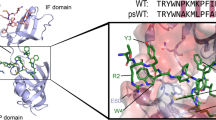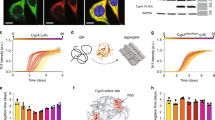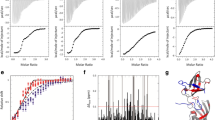Abstract
Two enzymes are now known that catalyse slow steps in protein folding. Peptidyl-prolyl cis-fraits isomerase1 catalyses the cis-trans isomerization of Xaa-Pro peptide bonds in oligopeptides and during the refolding of several proteins2,3. The other enzyme, protein-disulphide isomerase, accelerates the reactivation of reduced proteins, presumably by catalysis of thiol-disulphide exchange reactions4–6. Recent evidence indicates that the β-subunit of prolyl 4-hydroxylase, an enzyme involved in collagen biosynthesis, is identical with disulphide isomerase7,8. On the basis of this important finding, it was suggested9 that disulphide isomerase accelerates protein folding, not by 'reshuffling' incorrect disulphide bonds, but in the same way as prolyl isomerase by catalysing proline isomerization which is known to be important for the folding of collagen10 and other proteins. Here we show that the catalytic activities of these two enzymes are different. Disulphide isomerase accelerates the reformation of native disulphide bonds during protein reoxidation. We find no evidence that this enzyme can catalyse the isomerization of proline peptide bonds, a reaction efficiently accelerated by prolyl isomerase. When both enzymes are present simultaneously during protein folding, they act independently of one another.
Similar content being viewed by others
References
Fischer, G., Bang, H. & Mech, C. Biomed. biochim. Acta 43, 1101–1111 (1984).
Fischer, G. & Bang, H. Biochim. biophys. Acta 828, 39–42 (1984).
Lang, K., Schmid, F. X. & Fischer, G. Nature 329, 268–270 (1987).
Venetianer, P. & Straub, F. B. Biochim. biophys. Acta 67, 166–168 (1963).
Freedman, R. B. Trends biochem. Sci. 9, 438–441 (1984).
Freedman, R. B. Nature 329, 196–197 (1987).
Koivu, J. et al. J. biol. Chem. 262, 6447–6449 (1987).
Pihlajaniemi, T. et al. EMBO J. 6, 643–649 (1987).
Pain, R. M. Nature 328, 298 (1987).
Bächinger, H.-P., Bruckner, P., Timpl, R., Prockop, D. J. & Engel, J. Eur. J. Biochem. 106, 619–632 (1980).
Goto, Y. & Hamaguchi, K. J. molec. Biol. 156, 891–910 (1982).
Hillson, D. A., Lambert, N. & Freedman, R. B. Meth. Enzym. 107, 281–294 (1984).
Creighton, T. E., Hillson, D. A. & Freedman, R. B. J. molec. Biol. 142, 43–62 (1980).
Creighton, T. E. J. molec. Biol 113, 329–341 (1977).
Crook, E. M., Mathias, A. P. & Rabin, B. R. Biochem. J. 74, 234–238 (1960).
Author information
Authors and Affiliations
Rights and permissions
About this article
Cite this article
Lang, K., Schmid, F. Protein-disulphide isomerase and prolyl isomerase act differently and independently as catalysts of protein folding. Nature 331, 453–455 (1988). https://doi.org/10.1038/331453a0
Received:
Accepted:
Issue Date:
DOI: https://doi.org/10.1038/331453a0
- Springer Nature Limited
This article is cited by
-
Nuclear association of a T-cell transcription factor blocked by FK-506 and cyclosporin A
Nature (1991)
-
Effects of cyclosporine a on chick osteoclastsIn vitro
Calcified Tissue International (1991)
-
Peptidyl-prolyl cis-trans isomerase is the cyclosporin A-binding protein cyclophilin
Nature (1989)
-
Sensitivity to cyclosporin A is mediated by cyclophilin in Neurospora crassa and Saccharomyces cerevisiae
Nature (1989)
-
A protein with many functions?
Nature (1989)





